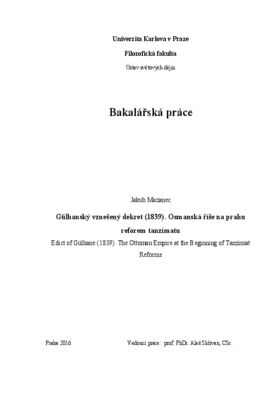Gülhanský vznešený dekret (1839). Osmanská říše na prahu reforem tanzimatu
Edict of Gülhane (1839). The Ottoman Empire at the Beginning of Tanzimat Reforms
bachelor thesis (DEFENDED)

View/
Permanent link
http://hdl.handle.net/20.500.11956/78215Identifiers
Study Information System: 163336
CU Caralogue: 990020972060106986
Collections
- Kvalifikační práce [24977]
Author
Advisor
Referee
Valkoun, Jaroslav
Faculty / Institute
Faculty of Arts
Discipline
History - European Studies
Department
Institute of General History
Date of defense
23. 6. 2016
Publisher
Univerzita Karlova, Filozofická fakultaLanguage
Czech
Grade
Excellent
Keywords (Czech)
Osmanská říše, reforma, reorganizace, tanzimat, Abdülmecid I, Mustafa Rešid Paša, Gülhanský dekret, Vznešený dekretKeywords (English)
Ottoman Empire, reform, reorganization, Tanzimat, Abdülmecid I, Mustafa Reshid Pasha, Gülhane Decree, Noble DecreeTato práce si klade za cíl analyzovat významnou událost moderních dějin Osmanské říše - vydání Gülhanského vznešeného dekretu, k němuž došlo 3. listopadu 1839. Sliby sultána Abdülmecida I. obsažené v tomto dokumentu otevřely dveře reformnímu období, tzv. období tanzimatu, které většinou bývá ohraničeno roky 1839-1876. Práce se věnuje také dřívějším pokusům o reorganizaci a modernizaci impéria, především reformám sultánů Selima III. a Mahmuda II., jejichž znalost je pro pochopení událostí roku 1839 nezbytná. Důležitou součástí práce je analýza okolností vzniku a samotného textu Gülhanského vznešeného dekretu vycházející z jeho anglického překladu.
This work deals with analysis of publication of Gülhane noble decree (3 November 1839) which is an eminent event in the modern history of the Ottoman Empire. Promises of sultan Abdülmecid I contained in this document in fact opened the door for a reform period called tanzimat, which is mostly put between years 1839-1876. This work also focuses on earlier attempts of reorganization and modernization of the empire, especially on reforms of sultan Selim III and sultan Mahmut II. Knowledge of these reforms is necessary for understanding the events of 1839. An important part of this work is formed by analysing circumstances of Gülhane decree origins and the English version of its text.
